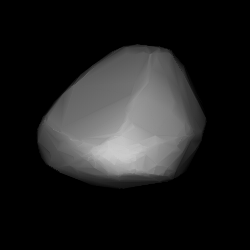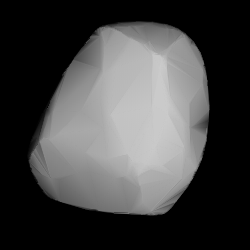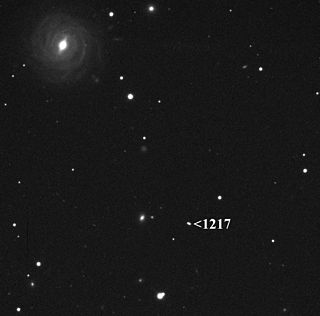
332 Siri is a main belt asteroid in orbit around the Sun. It was discovered by German astronomer Max Wolf on 19 March 1892 in Heidelberg. The origin of this asteroid's name is unclear. On October 5, 2092, 332 Siri will pass 4,981,670 km (3,095,470 mi) from the asteroid 29 Amphitrite with a relative velocity of 2.054 kilometers per second.

340 Eduarda is a main belt asteroid that was discovered by German astronomer Max Wolf on 25 September 1892 in Heidelberg. It was named after German banker and amateur astronomer Heinrich Eduard von Lade.

353 Ruperto-Carola is a background asteroid from the central region of the asteroid belt. It was discovered by German astronomer Max Wolf at the Heidelberg Observatory on 16 January 1893. It is named after the Ruprecht Karls University, whose Latin name is Ruperto Carola Heidelbergensis.

377 Campania is a large main belt asteroid that was discovered by French astronomer Auguste Charlois on 20 September 1893 in Nice.

385 Ilmatar is a large main belt asteroid.
421 Zähringia, provisional designation 1896 CZ, is a stony asteroid from the intermediate asteroid belt, approximately 14 kilometers in diameter. It was discovered on 7 September 1896, by astronomer Max Wolf at Heidelberg Observatory in Germany. The asteroid was named for the House of Zähringen, a medieval noble family that ruled parts of Swabia and Switzerland.

450 Brigitta is a typical Main belt asteroid. It is a member of the Eos family.
459 Signe, provisional designation 1900 FM, is a stony asteroid from the background population of the intermediate asteroid belt, approximately 26 kilometers in diameter. It was discovered by German astronomer Max Wolf at Heidelberg-Königstuhl State Observatory on 22 October 1900. The asteroid was presumably named after Signy, a character of the Scandinavian Völsunga saga and Norse mythology. Signy is the daughter of Völsung and sister of Sigmund.
494 Virtus is an 86 km minor planet orbiting the Sun. It was discovered by Max Wolf on October 7, 1902. Its provisional name was 1902 JV.
513 Centesima is a 50 km Main-belt asteroid orbiting the Sun. It is one of the core members of the Eos family of asteroids. Relatively little is known about this tiny asteroid. It is not known to possess any natural satellites, so its mass is unknown. However, its brief rotation period of just over 5 hours implies that the body must be exceptionally dense, for its gravity is able counteract the centrifugal force. It was discovered 24 August 1903 by late-nineteenth- and early-twentieth-century astronomer Max Wolf. It was his 100th asteroid discovery, hence the name, which in Latin, means "hundredth".
549 Jessonda is a minor planet orbiting the Sun. According to the Catalogue of Minor Planet Names and Discovery Circumstances, it is "named presumably after the character in the opera of the same name by the German composer, conductor and violinist Ludwig Spohr (1784-1859), one of the leading composers in the early romantic period.'

553 Kundry is an S-type asteroid belonging to the Flora family in the Main Belt. Its rotation period is 12.605 hours.
574 Reginhild is a minor planet orbiting the Sun that was discovered by German astronomer Max Wolf on September 19, 1905. The name may have been inspired by the asteroid's provisional designation 1905 RD.

605 Juvisia is a minor planet, specifically an asteroid orbiting in the asteroid belt that was discovered 27 August 1906 in Heidelberg by German astronomer Max Wolf. It was named after the commune Juvisy-sur-Orge, France, where French astronomer Camille Flammarion had his observatory.
610 Valeska is a minor planet, specifically an asteroid, orbiting primarily in the asteroid belt. Discovered in 1906 by Max Wolf. The origin of the name is unknown, but it may be related to the provisional designation 1906 VK. In Slavic origin, it also means Glorious ruler. Photometric observations provide a rotation period of 4.9047±0.0002 h with a brightness variation of 0.17±0.03 in magnitude.
815 Coppelia is a minor planet orbiting the Sun that was discovered by German astronomer Max Wolf on 2 February 1916 from Heidelberg named after Coppélia, a comic ballet.
860 Ursina is a minor planet orbiting the Sun that was discovered in 1917 by German astronomer Max Wolf. The origin of the name is unknown.
863 Benkoela is an A-type asteroid orbiting the Sun that was discovered by German astronomer Max Wolf on 9 February 1917 from Heidelberg.
880 Herba is a minor planet orbiting the Sun that was discovered by German astronomer Max Wolf on 22 July 1917 in Heidelberg.

1217 Maximiliana, provisional designation 1932 EC, is a background asteroid from the inner regions of the asteroid belt, approximately 17 kilometers (11 mi) in diameter. It was discovered on 13 March 1932, by Belgian astronomer Eugène Delporte at the Royal Observatory of Belgium in Uccle. The asteroid was named in memory of Max Wolf, a German astronomer and discoverer of asteroids himself, who independently discovered this asteroid.









